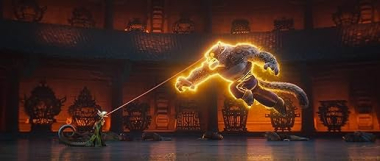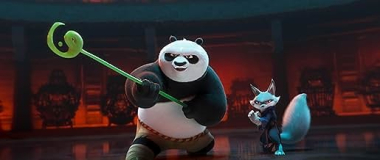Kung Fu Panda 4 Review
I found myself unexpectedly swept into the vibrant world of Kung Fu Panda from the very first moment I saw its colorful presentation. Being someone who has grown up loving animated adventures, I was drawn not only by the promise of martial arts excitement, but also by the deep emotional undertones that the film hinted at from its opening scenes. I remember sitting in a quiet room, eyes fixed on the screen, and feeling the anticipation of being introduced to a narrative that was as much about inner growth as it was about external conquest. The movie opened up a universe that blended the exciting realms of martial arts with the warm humor and delicate philosophies of life, captivating me in a manner that few animated features have managed before. Every character felt distinct and dynamic, and there was a tangible pulse of energy that resonated deep within me as the world began to unfold in layers of visual artistry and heartfelt dialogue.
From the outset, it was clear that this was not just another animated film; it was a blend of mythic storytelling and a modern sensibility, inviting its audience into a journey where humor met wisdom. I was immediately engaged by the beautiful mixture of vivid colors and intricate character designs, which promised an escapade as visually exhilarating as it was emotionally stirring. The film’s unique narrative style, which balanced moments of introspection with bursts of frenetic energy, reminded me of the importance of embracing life’s unpredictability and unconventional heroes. I found myself reflecting on my own experiences and how sometimes the most unexpected paths lead to the most life-altering adventures. The world of Kung Fu Panda was rich, detailed, and promising—a perfect blend of energy, passion, and quiet determination.
Diving into a World of Immersive Animation
As I continued to watch Kung Fu Panda, the first aspect that caught my eye was the breathtaking animation style, which felt both innovative and deeply respectful of traditional martial arts aesthetics. Every frame was a work of art, blending a meticulous attention to detail with fluid, expressive movements that truly brought the characters to life. I was particularly impressed by the seamless integration of dynamic landscapes and dramatic fight scenes that felt choreographed with an almost balletic grace. The artistry in the design of the vibrant backgrounds, the carefully drawn settings, and the subtle interplay of light and shadow elevated the entire experience, making each scene a visual delight. Every time the camera panned across a beautifully rendered scene, I felt as if I were witnessing an intricately woven tapestry of ancient lore and modern storytelling.
The effects and smooth transitions were an absolute treat for someone who appreciates the technical mastery behind animated storytelling. The film’s ability to convey the fluid motion of martial arts with such artistic elegance truly amazed me. In one memorable sequence, the character’s movements were so exquisitely drawn that I paused the movie to admire the precision with which each kick, jump, and spin was executed. It was apparent that the creators had poured countless hours into refining the animation to ensure that these motion sequences were both authentic and dynamically engaging. The interplay of color, lighting, and motion captured the essence of martial arts, making the viewing journey a continuous exploration into what it means to merge art with action. Every visual element was meticulously crafted to convey not just movement, but emotion and intent, drawing me deeper into the narrative with every scene.
Exploring the Richness of Character Development
One of the most engrossing elements of Kung Fu Panda for me was the intricate and heartfelt character development woven throughout its narrative. I found myself instantly connecting with the essence of each character, particularly the protagonist, whose journey was a profound exploration of self-discovery and courage. Watching his evolution from uncertainty to confidence was a deeply personal experience, as I could relate to the internal struggles and the eventual acceptance of one's unique strengths. The narrative did an exceptional job of showing that greatness does not solely depend on external prowess, but is forged through self-belief and the willingness to embrace one's inner wisdom. Every interaction, every challenge faced, and every quiet moment of introspection added layers to his persona that resonated with my own experiences and aspirations.
In addition to the central character, the supporting cast was crafted with equal care. Each mentor, friend, and even the occasional adversary brought a distinct flavor to the story. Their individual arcs, however brief, were imbued with lessons about honor, perseverance, and the importance of community. I found myself smiling at the subtle humor interspersed among the serious moments, and yet I was equally moved by the scenes that evoked deep-seated empathy. The movie did an extraordinary job of balancing moments of witty banter with reflective instances of vulnerability, making the characters feel alive and relatable. Their journey, replete with moments of triumph and introspection, mirrored the unpredictable paths we walk in life, where every encounter is a step towards not just external victory, but personal enlightenment.
Embracing the Spirit of Martial Arts
One cannot discuss Kung Fu Panda without mentioning the breathtaking portrayal of martial arts that is interlaced with the film’s narrative fabric. I was captivated by how the movie transformed what could easily have been seen as mere action sequences into profound expressions of art and philosophy. The choreography was remarkably fluid and poetic, demonstrating that martial arts transcend physical combat and are, in fact, a discipline of the mind and spirit. Every movement had a purpose, meticulously crafted to convey a story of resilience and agile adaptation. I found that each action scene was not just about physicality, but also a symbolic representation of the internal struggle between doubt and self-assurance.
The precision with which the martial arts were animated reminded me of the beauty inherent in detailed practice and unwavering dedication. I reflected on the time and effort required to master such refined movements, which in turn elevated the film’s narrative by equating the external battles with internal trials. This deep-seated love for martial arts is woven into the soul of the movie, and it resonated with me on a personal level. I appreciated how the film celebrated tradition while seamlessly integrating modern elements to create a narrative that was both inspirational and visually arresting. The way in which the filmmakers made martial arts an allegory for the struggles we face in our own lives truly set the movie apart from other animated adventures I had seen before.
Savoring the Musical and Sonic Delights
The film’s auditory landscape left me utterly enchanted as I delved deeper into the world of Kung Fu Panda. The soundtrack was not merely an accompaniment but served as a storyteller in its own right. The musical score was meticulously composed, blending traditional tunes with modern orchestral flourishes, and it echoed the film’s thematic blend of heritage and innovation. Every note felt intentional, striking a chord with the vibrant visuals and layered character dynamics. As I sat in the theater, the stirring melodies seemed to enhance my emotional engagement, amplifying the laughter, tension, and even the quiet moments of reflection that punctuated the narrative.
I was particularly taken by how the sound design integrated elements of traditional instruments, invoking a sense of cultural authenticity that was both respectful to the origins of martial arts and refreshingly innovative. The strategic use of percussion and melodic lines in crucial moments added a rhythmic heartbeat to the film, making each scene feel more alive and immersive. I often found myself closing my eyes for brief moments, allowing the sonic narrative to transport me further into the world that the filmmakers had so expertly crafted. The seamless fusion of sound with the exquisite visual artistry made the overall experience not just engaging, but deeply moving. The musical echoes resonated with my own life experiences, evoking memories of past adventures and inspiring a sense of quiet determination in the face of challenges.
Cultural Resonance and Mythical Undertones
One of the aspects of Kung Fu Panda that truly left an indelible mark on my mind was its earnest celebration of cultural heritage and mythical undertones. The filmmakers exhibited a profound respect for the traditions embedded within the martial arts genre and allowed that to guide the movie's narrative and aesthetic choices. As I watched, I felt an increasing awareness of how culture and mythology could shape a story, imbuing it with both timeless wisdom and a modern vibrancy. The narrative was peppered with nods to traditional legends and philosophies that connected the story to a larger, almost mythic framework. I found it fascinating how these elements were woven so seamlessly into a plot that was as entertaining as it was thought-provoking.
The incorporation of these cultural elements did more than provide an exotic backdrop; it added layers of meaning to every scene. The characters, their challenges, and their triumphs all spoke to universal themes of honor, destiny, and self-awareness, echoing ancient tales of heroism and sacrifice. I felt as though the movie was a bridge between the past and the present, an invitation to explore a forgotten world that still held relevance in modern times. The imagery, steeped in rich cultural symbolism, deepened my appreciation for the art of storytelling and made me ponder on the intricate connections between tradition and innovation. Each frame whispered a tale of legacy and the enduring strength of cultural narratives, making my viewing experience both enriching and exhilarating.
The Art of Humorous Wit and Lighthearted Banter
Throughout the movie, the infusion of humor and lighthearted banter provided a delightful counterbalance to the more intense moments of dramatic reflection. I found myself smiling repeatedly at the clever comic relief the characters brought to the storyline, which added a genuine sense of warmth and accessibility. The humor was not merely for entertainment; it served as an essential narrative tool that revealed character idiosyncrasies and built a relatable world of endearing quirks and flaws. I recall how a seemingly casual exchange between characters turned into an unexpectedly poignant moment, blending laughter with a hint of bittersweet truth about the nature of struggle and perseverance. The humor in Kung Fu Panda was crafted with precision, ensuring that it felt natural and heartfelt rather than forced or simply added for effect.
In many instances, I was amused by the spontaneous wit that emerged in the midst of chaos, providing a brief respite from the more challenging elements of the story. The timing was impeccable, and the dialogues were laced with nuances that showcased the deep understanding the writers had of their audience. It felt as though the film itself was in on the joke about life's unpredictable twists. Even during scenes that were packed with tension, there was a spark of humor that reminded me to view life with a lighter heart and a more open mind. This balance of humor and depth added another layer of authenticity to the narrative, making it more reflective of the complex interplay between joy and sorrow in everyday life.
Experiencing the Dynamic Action and Choreography
One segment of Kung Fu Panda that left me utterly captivated was the dynamic arrangement of action and the intricacies of the fight choreography. As someone who has always been fascinated by martial arts, I found the film’s sequences to be a superb demonstration of how movement can be transformed into poetry. The scenes were not just random displays of martial prowess; they were meticulously designed to convey emotion, character development, and the philosophies inherent in martial arts. With every choreographed battle, I felt a surge of adrenaline as the characters executed moves that were both precise and expressive. I marveled at the physical storytelling that took place in these sequences, where every flip, pivot, and parry was imbued with meaning, reflecting the internal battles each character fought.
The fluidity and precision of the action was a testament to the countless hours of rehearsal—albeit animated—behind the scenes. The way the cinematography captured these moments made it possible for me to appreciate the skill and artistry behind the choreography. I found myself getting lost in the rhythm of the movements as they transitioned from softness to explosive bursts of action, echoing the ebb and flow of life’s own journey between calm and storm. The fight scenes did not feel gratuitous; instead, they were a crucial part of the narrative, highlighting the importance of discipline, focus, and the delicate balance between strength and humility. As each action moment unfolded, I became more and more invested, drawn into a captivating interplay of physical excellence and powerful emotion.
Uncovering the Emotional Landscape of the Tale
Beyond the dazzling visuals and energetic combat, what truly resonated with me was the profound emotional landscape that Kung Fu Panda offered its audience. The movie took me on a journey that went well beyond physical adventures; it delved into the depths of personal growth, identity, and the conflicts we all experience within ourselves. I found myself empathizing with the characters on a deeply personal level. The film was rich with moments of vulnerability, where the protagonist and his allies experienced internal dilemmas that mirrored the challenges I’ve faced in my own life. It was in these quieter, introspective moments that I discovered the true heart of the story—one that celebrated the journey towards self-acceptance and the bravery it takes to dare greatly.
There were scenes that left me with a lingering sense of introspection, where the struggles of the characters seemed to echo the internal challenges of everyday life. The narrative pushed me to question what it means to be truly courageous and whether the battles we face are as external as they seem. Every carefully constructed moment was a reminder that life is a delicate interplay of joy and insecurity, and that it is through embracing our imperfections that we discover our most remarkable strengths. The emotional depth of the film was not just an artistic choice; it was an invitation to reassess my own journey and recognize that the path to inner peace is paved with both obstacles and unexpected moments of grace.
Reveling in the Vibrancy of Storytelling and Dialogue
The dialogue and narrative style of Kung Fu Panda were standout elements that left an enduring mark on me. I was struck by how each line of conversation was crafted to reveal character, deepen the plot, and occasionally, spark a moment of humorous levity. The warmth and sincerity embedded in the words resonated with my own belief in the power of storytelling to transform and uplift. There was an artful balance between earnest philosophical reflections and moments of playful camaraderie, a balance that made the storytelling feel both mature and accessible. The conversations were never merely a vehicle for exposition; instead, they became a medium through which the characters' inner lives were unveiled, offering a window into their hopes, fears, and dreams.
Every dialogue exchange, no matter how subtle, carried layers of meaning that kept me engaged throughout the film. I appreciated the way the narrative seamlessly transitioned from light-hearted banter to more serious discussions about honor, destiny, and self-discovery. One particular scene resonated with me because of the surprisingly profound insights delivered through what initially seemed like casual talk. This thoughtful interplay of words and ideas was not only entertaining but also served as a reminder that sometimes the simplest conversations can encapsulate the deepest truths. The dialogue felt organic and alive, inviting me as a viewer to become an active participant in the unfolding story. It was a masterclass in how words, when chosen with care, can elevate a narrative and leave a lasting impact on the soul.
Finding Personal Reflections in the Film
Throughout my viewing experience of Kung Fu Panda, I consistently found myself drawing parallels to my own personal journey. The narrative was rich with themes of self-discovery, perseverance, and the importance of embracing our authentic selves. I was deeply moved by the protagonist’s reluctant yet transformative path from self-doubt to confident determination. His story served as a mirror, reflecting my own internal battles and aspirations. I found that as he navigated the challenges laid out before him, his journey invited me to question my own perceptions and hesitations. Every setback he encountered was a reminder that vulnerability is an inherent part of growth, and every triumph was a celebration of the human spirit’s resilience.
This personal connection was not limited to the protagonist alone; the whole ensemble of characters, with their diverse backgrounds and conflicting viewpoints, contributed to a narrative that mirrored the complexity of life itself. Their interactions, punctuated by moments of heartfelt sincerity and unexpected humor, opened my eyes to the beauty of embracing both our strengths and vulnerabilities. The depiction of internal struggles was so poignantly rendered that I felt an inherent kinship with the characters, recognizing in their narratives the universal quest for acceptance, purpose, and belonging. This film did more than entertain me; it offered a space for introspection and self-affirmation, reminding me that the path to self-understanding is a winding journey filled with both challenges and moments of extraordinary beauty.
Screenshots






Leave a comment
Your comment is awaiting moderation. We save your draft here
0 Comments